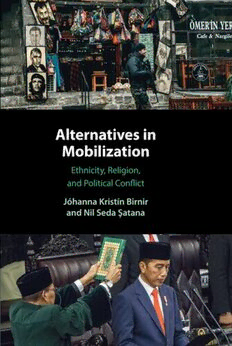
Alternatives in Mobilization Ethnicity, Religion, and Political Conflict PDF
Preview Alternatives in Mobilization Ethnicity, Religion, and Political Conflict
Alternatives in Mobilization Ethnicity, Religion, and Political Conflict JÓHANNA KRISTÍN BIRNIR UniversityofMaryland NI˙L SEDA S¸ATANA UniversityofMaryland (cid:19)(cid:6)(cid:12)(cid:11)(cid:17)(cid:10)(cid:8)(cid:7)(cid:1)(cid:15)(cid:14)(cid:12)(cid:11)(cid:14)(cid:8)(cid:1)(cid:6)(cid:21)(cid:1)(cid:2)(cid:5)(cid:13)(cid:6)(cid:16)(cid:11)(cid:7)(cid:9)(cid:8)(cid:1)(cid:4)(cid:14)(cid:11)(cid:20)(cid:8)(cid:16)(cid:17)(cid:11)(cid:18)(cid:21)(cid:1) (cid:16)(cid:8)(cid:17)(cid:17) UniversityPrintingHouse,Cambridgecb28bs,UnitedKingdom OneLibertyPlaza,20thFloor,NewYork,ny10006,USA 477WilliamstownRoad,PortMelbourne,vic3207,Australia 314–321,3rdFloor,Plot3,SplendorForum,JasolaDistrictCentre, NewDelhi–110025,India 103PenangRoad,#05–06/07,VisioncrestCommercial,Singapore238467 CambridgeUniversityPressispartoftheUniversityofCambridge. ItfurtherstheUniversity’smissionbydisseminatingknowledgeinthepursuitof education,learning,andresearchatthehighestinternationallevelsofexcellence. www.cambridge.org Informationonthistitle:www.cambridge.org/9781108419840 doi:10.1017/9781108304306 ©JóhannaKristínBirnirandNilSedaS¸atana2022 Thispublicationisincopyright.Subjecttostatutoryexception andtotheprovisionsofrelevantcollectivelicensingagreements, noreproductionofanypartmaytakeplacewithoutthewritten permissionofCambridgeUniversityPress. Firstpublished2022 AcataloguerecordforthispublicationisavailablefromtheBritishLibrary. LibraryofCongressCataloging-in-PublicationData Names:Birnir,JóhannaKristín,1969–author. S¸atana,NilSeda,1976–author. | Title:Alternativesinmobilization:ethnicity,religion,andpoliticalconflict JóhannaKristínBirnir,NilSedaS¸atana. Description:Cambridge;NewYork,NY:CambridgeUniversityPress,2022. | Includesbibliographicalreferencesandindex. Identifiers:LCCN2021053371(print) LCCN2021053372(ebook) | | ISBN9781108419840(hardback) ISBN9781108412261(paperback) | | ISBN9781108304306(epub) Subjects:LCSH:Politicalparticipation–Casestudies. Ethnicity–Politicalaspects–Casestudies. | | Religionandpolitics–Casestudies. Demography–Politicalaspects–Casestudies. | | Politicalgeography–Casestudies. BISAC:POLITICALSCIENCE/General | Classification:LCCJF799.B572022(print) LCCJF799(ebook) DDC323/.042–dc23/eng/20220206 | | LCrecordavailableathttps://lccn.loc.gov/2021053371 LCebookrecordavailableathttps://lccn.loc.gov/2021053372 isbn978-1-108-41984-0Hardback CambridgeUniversityPresshasnoresponsibilityforthepersistenceoraccuracyof URLsforexternalorthird-partyinternetwebsitesreferredtointhispublication anddoesnotguaranteethatanycontentonsuchwebsitesis,orwillremain, accurateorappropriate. (cid:19)(cid:6)(cid:12)(cid:11)(cid:17)(cid:10)(cid:8)(cid:7)(cid:1)(cid:15)(cid:14)(cid:12)(cid:11)(cid:14)(cid:8)(cid:1)(cid:6)(cid:21)(cid:1)(cid:2)(cid:5)(cid:13)(cid:6)(cid:16)(cid:11)(cid:7)(cid:9)(cid:8)(cid:1)(cid:4)(cid:14)(cid:11)(cid:20)(cid:8)(cid:16)(cid:17)(cid:11)(cid:18)(cid:21)(cid:1) (cid:16)(cid:8)(cid:17)(cid:17) Maya,ÓðinnandSigþór (cid:19)(cid:6)(cid:12)(cid:11)(cid:17)(cid:10)(cid:8)(cid:7)(cid:1)(cid:15)(cid:14)(cid:12)(cid:11)(cid:14)(cid:8)(cid:1)(cid:6)(cid:21)(cid:1)(cid:2)(cid:5)(cid:13)(cid:6)(cid:16)(cid:11)(cid:7)(cid:9)(cid:8)(cid:1)(cid:4)(cid:14)(cid:11)(cid:20)(cid:8)(cid:16)(cid:17)(cid:11)(cid:18)(cid:21)(cid:1) (cid:16)(cid:8)(cid:17)(cid:17) (cid:19)(cid:6)(cid:12)(cid:11)(cid:17)(cid:10)(cid:8)(cid:7)(cid:1)(cid:15)(cid:14)(cid:12)(cid:11)(cid:14)(cid:8)(cid:1)(cid:6)(cid:21)(cid:1)(cid:2)(cid:5)(cid:13)(cid:6)(cid:16)(cid:11)(cid:7)(cid:9)(cid:8)(cid:1)(cid:4)(cid:14)(cid:11)(cid:20)(cid:8)(cid:16)(cid:17)(cid:11)(cid:18)(cid:21)(cid:1) (cid:16)(cid:8)(cid:17)(cid:17) Contents ListofFigures pagexi ListofTables xiii Acknowledgments xvii 1Introduction 1 1.1 Introduction 1 1.2 TheLiterature 4 1.2.1 ThePuzzles 6 1.2.2 Scope,Assumptions,andTerms 6 1.3 TheArgument 12 1.3.1 AlternativesinMobilization:DemographyofIdentity asanExplanatoryVariable 12 1.4 EmpiricalContributions 15 1.4.1 TheNewA-ReligionDataandCaseAnalyses 15 1.5 ArgumentsOutsidetheScopeofThisBook 16 1.5.1 TheOnsetorSuccessofCollectiveMobilization 16 1.5.2 Identity Groups’ Pursuit of Peaceful versus Violent StrategiesinPoliticalContestation 17 1.5.3 What’sinaName?ReligionorReligion,andReligion orEthnicity 18 1.5.4 A Panacea for Explaining Ethnic and Religious Mobilization 20 1.6 OutlineoftheBook 20 2DemographyofIdentityinPoliticaliCcflton 25 2.1 Introduction 25 2.2 Demographics and Political Violence between Religiously SegmentedGroups 27 vii (cid:19)(cid:6)(cid:12)(cid:11)(cid:17)(cid:10)(cid:8)(cid:7)(cid:1)(cid:15)(cid:14)(cid:12)(cid:11)(cid:14)(cid:8)(cid:1)(cid:6)(cid:21)(cid:1)(cid:2)(cid:5)(cid:13)(cid:6)(cid:16)(cid:11)(cid:7)(cid:9)(cid:8)(cid:1)(cid:4)(cid:14)(cid:11)(cid:20)(cid:8)(cid:16)(cid:17)(cid:11)(cid:18)(cid:21)(cid:1) (cid:16)(cid:8)(cid:17)(cid:17) viii Contents 2.2.1 Africa 29 2.2.2 SouthandSouth-eastAsia 33 2.3 TheData:Ethnicity,Religion,andPoliticalConflict 35 2.3.1 ExistingGroup-LevelData 36 2.3.2 TheAMARandA-ReligionData 38 2.4 Demographic Diversity and Over-Representation of Islamic GroupsinCivilConflict 41 2.5 GroupSize,Ethno-Religion,andPoliticalContestation 48 2.5.1 TheGeoAMARData 48 2.5.2 TheReligionsofEthnicGroups 49 2.6 Conclusion 55 3TheTheory: AlternativesinMobilization 56 3.1 Introduction 56 3.2 Segmented and Shared Identity Mobilization and Relative GroupSize 57 3.2.1 SegmentedIdentity 57 3.2.2 SharedIdentity 60 3.2.3 TheMinimumWinningCoalition(MWC) 68 3.2.4 TheChallenger’sWinningCoalition(CWC) 72 3.3 Formalization: Segmented and Shared Identity Mobilization andRelativeGroupSize 74 3.3.1 SegmentedIdentityandPoliticalMobilization 75 3.3.2 SharedIdentityandPoliticalMobilization 81 3.3.3 TestableImplications 84 3.4 InterveningInstitutions 86 3.5 Conclusion 90 4Testingthe Challenger’sWinningCoalitionHypothesison MobilizationofReligioninEthnicCivilWar 92 4.1 Introduction 92 4.1.1 WhyReligionandWhyNow? 94 4.2 TheData 96 4.2.1 TheUniverseofCases 99 4.2.2 TheUnitofAnalysis:FromOrganizationstoGroups 101 4.2.3 ProbingtheData:A-ReligionandRELAC 104 4.3 Variables 111 4.3.1 Independent Variables: Demography and Shared Religion 111 4.3.2 DependentVariable:ReligiousIncompatibility 113 4.3.3 ControlVariables 114 4.4 Testing 114 4.4.1 StrategiesinCivilWar 114 4.4.2 RegressionAnalysis 116 4.4.3 RobustnessoftheResults 119 (cid:19)(cid:6)(cid:12)(cid:11)(cid:17)(cid:10)(cid:8)(cid:7)(cid:1)(cid:15)(cid:14)(cid:12)(cid:11)(cid:14)(cid:8)(cid:1)(cid:6)(cid:21)(cid:1)(cid:2)(cid:5)(cid:13)(cid:6)(cid:16)(cid:11)(cid:7)(cid:9)(cid:8)(cid:1)(cid:4)(cid:14)(cid:11)(cid:20)(cid:8)(cid:16)(cid:17)(cid:11)(cid:18)(cid:21)(cid:1) (cid:16)(cid:8)(cid:17)(cid:17) Contents ix 4.4.4 AlternativeExplanation:TheChallenger’sWinning CoalitionorSectarianWar? 122 4.5 Conclusion 124 5TheInternalValidityofthe Challenger’sWinningCoalition Hypothesis 126 5.1 Introduction 126 5.1.1 CasesThatDoNotConform 131 5.2 Exploring the Internal Validity of the Challenger’s Winning CoalitionHypothesisinCivilWar 132 5.2.1 Islam:Pakistan 132 5.2.2 Christianity:Uganda 136 5.2.3 Hinduism:Nepal 146 5.3 CasesThatDoNotConform:OrDoThey? 155 5.3.1 Turkey 156 5.4 Conclusion 166 6The Challenger’sWinningCoalitioninIndonesia’sElectoralPolitics 167 6.1 Introduction 167 6.2 Indonesia 169 6.3 IdentityinIndonesianPoliticsfromIndependence throughRe-democratization 170 6.3.1 Fromthe“NewOrder”throughRe-democratization 174 6.4 Indonesia’sInstitutions 177 6.4.1 AdministrativeDivisionsandElectedBodies 178 6.4.2 PartyandElectionLaw 182 6.5 DataonEthnicityandReligion 186 6.6 TheCWCinNational-levelPolitics 187 6.6.1 National-levelDemographics 187 6.6.2 National-levelInstitutions 188 6.7 TheCWCattheProvincialLevel 191 6.7.1 TheProvinces 193 6.7.2 TheCaseofKepri 198 6.7.3 Natives,Migrants,andtheCWCinKepri 204 6.8 CWCatLowerAdministrativeLevels 206 6.8.1 TheCityofMedan,NorthSumatra 206 6.9 Conclusion 211 6.9.1 TheSundanese 211 6.9.2 LessonsLearned 213 7Conclusion 215 7.1 LessonsLearnedandthePathForward 215 7.2 FutureResearch 218 7.2.1 IdentityMobilizationandLevelsofAnalysis 219 7.2.2 GroupSizeandIdentifiability 221 7.2.3 SalienceandPoliticalActivationofIdentity 223 (cid:19)(cid:6)(cid:12)(cid:11)(cid:17)(cid:10)(cid:8)(cid:7)(cid:1)(cid:15)(cid:14)(cid:12)(cid:11)(cid:14)(cid:8)(cid:1)(cid:6)(cid:21)(cid:1)(cid:2)(cid:5)(cid:13)(cid:6)(cid:16)(cid:11)(cid:7)(cid:9)(cid:8)(cid:1)(cid:4)(cid:14)(cid:11)(cid:20)(cid:8)(cid:16)(cid:17)(cid:11)(cid:18)(cid:21)(cid:1) (cid:16)(cid:8)(cid:17)(cid:17) x Contents 7.2.4 Intersectionality 225 AppendixA AMARGroupsandtheA-ReligionDataSet 227 A.1 SupplementaryTables 227 AppendixB FormalRepresentationoftheTheoryofAlternatives inMobilization 233 B.1 SegmentedCleavages 234 B.1.1 ExpectedUtility 234 B.2 SharedIdentityandMobilization 235 B.3 ModelVariations 237 AppendixC TransformationofRELACDatatoGroupLeveltoMatch withtheA-ReligionDataSet 241 C.1 ProbingtheData:FromOrganizationstoGroups 241 C.1.1 CollapsingOrganizations 241 C.1.2 ExpandingGroupObservations 244 Bibliography 257 Index 287 (cid:19)(cid:6)(cid:12)(cid:11)(cid:17)(cid:10)(cid:8)(cid:7)(cid:1)(cid:15)(cid:14)(cid:12)(cid:11)(cid:14)(cid:8)(cid:1)(cid:6)(cid:21)(cid:1)(cid:2)(cid:5)(cid:13)(cid:6)(cid:16)(cid:11)(cid:7)(cid:9)(cid:8)(cid:1)(cid:4)(cid:14)(cid:11)(cid:20)(cid:8)(cid:16)(cid:17)(cid:11)(cid:18)(cid:21)(cid:1) (cid:16)(cid:8)(cid:17)(cid:17) Figures 2.1 Thechangeovertimeinproportionofacountry’spopulation belongingtoanyofthethreemostpopulousreligiousfamilies (Christianity,Islam,andHinduism)intheworld page28 2.2 Thechangeovertimeinproportionofacountry’spopulation belongingtoanyofthethreemostpopulousreligiousfamilies (Christianity (white),Islam (black),and Hinduism (gray)) inAfrica 30 2.3 The change over time in absolute numbers of people belonging to any of the three most populous religious families (Christianity, Islam, and Hinduism) inAfrica 31 2.4 The change over time in absolute numbers of people belonging to any of the three most populous religious families(Christianity(white),Islam(black),Hinduism(gray)) in South-east Asia (including also India, Pakistan, and Bangladesh) 34 2.5 The number of socially relevant ethnic groups belonging to eachofthecodedfamiliesofreligion 42 2.6 ThenumberofsociallyrelevantChristianandMuslimethnic groupsbelongingtoeachofthecodedsects 43 2.7 GeoAMARpolygonsrepresentingmappablegroupsacrossthe worlddata 50 2.8 A-ReligionasmappedinGeoAMAR 51 2.9 Ethnicgroupreligionsinsub-SaharanAfrica 51 2.10 EthnicgroupreligionsinAsia 52 2.11 EthnicgroupreligionsinLatinAmerica 52 2.12 Ethno-religiousgroupproportionsofnationalpopulationsin Africa 53 xi (cid:19)(cid:6)(cid:12)(cid:11)(cid:17)(cid:10)(cid:8)(cid:7)(cid:1)(cid:15)(cid:14)(cid:12)(cid:11)(cid:14)(cid:8)(cid:1)(cid:6)(cid:21)(cid:1)(cid:2)(cid:5)(cid:13)(cid:6)(cid:16)(cid:11)(cid:7)(cid:9)(cid:8)(cid:1)(cid:4)(cid:14)(cid:11)(cid:20)(cid:8)(cid:16)(cid:17)(cid:11)(cid:18)(cid:21)(cid:1) (cid:16)(cid:8)(cid:17)(cid:17)
